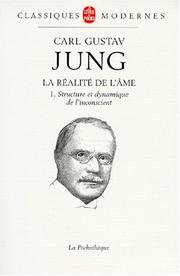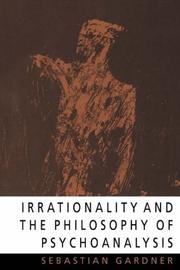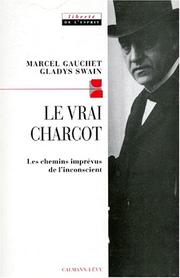| Listing 1 - 8 of 8 |
Sort by
|
Book
ISBN: 9789401404310 Year: 2012 Publisher: Tielt Lannoo
Abstract | Keywords | Export | Availability | Bookmark
 Loading...
Loading...Choose an application
- Reference Manager
- EndNote
- RefWorks (Direct export to RefWorks)
Cognitive psychology --- Developmental psychology --- Affective and dynamic functions --- Brain --- Brein --- Cerebrum --- Cerveau --- Hersenen --- Inconscient --- Mind --- Onbewuste --- Onderbewuste --- Onderbewustzijn --- Subconscient --- Subconsciousness --- Unconsciousness --- neurologie --- brein

ISBN: 2253132373 9782253132370 Year: 1998 Volume: 1 Publisher: Paris La Pochothèque/Librairie Générale Française
Abstract | Keywords | Export | Availability | Bookmark
 Loading...
Loading...Choose an application
- Reference Manager
- EndNote
- RefWorks (Direct export to RefWorks)
Inconscient --- Onbewuste --- Onderbewuste --- Onderbewustzijn --- Subconscient --- Subconsciousness --- Unconsciousness --- Psychanalyse. --- Inconscient. --- Âme --- Psychothérapie --- Typologie (Psychologie) --- Energie psychique. --- Archetype (Psychologie) --- Transfert (Psychologie) --- Aspect psychologique --- Archétype (Psychologie) --- Âme - Aspect psychologique

ISBN: 3826029453 Year: 2005 Publisher: Würzburg Königshausen und Neumann
Abstract | Keywords | Export | Availability | Bookmark
 Loading...
Loading...Choose an application
- Reference Manager
- EndNote
- RefWorks (Direct export to RefWorks)
Duits idealisme --- German idealism --- Idealism [German ] --- Idealisme [Duits ] --- Idéalisme absolu --- Idéalisme allemand --- Idéalisme objectif --- Idéalisme subjectif --- Inconscient --- Onbewuste --- Onderbewuste --- Onderbewustzijn --- Subconscient --- Subconsciousness --- Unconsciousness
Book
ISBN: 9782711860616 Year: 2013 Publisher: Paris Réunion des musées nationaux
Abstract | Keywords | Export | Availability | Bookmark
 Loading...
Loading...Choose an application
- Reference Manager
- EndNote
- RefWorks (Direct export to RefWorks)
Bien antérieur aux interprétations de la psychanalyse et aux découvertes des neurosciences, ce que l'on pourrait appeler l'"ancien régime" du rêve repose sur l'idée que le sommeil et les songes nous mettent en relation avec les puissances de l'au-delà. Aussi les hommes de la Renaissance doivent-ils affronter une redoutable question : en s'évadant des contraintes de son propre corps, le rêveur peut-il entrer en contact avec le divin, ou se trouve-t-il au contraire livré à des "démons" étrangers ? La réponse des artistes des XVe et XVIe siècles à une question plus troublante encore - comment représenter ce que rêve un rêveur ? - est particulièrement fascinante. Si certains explorent le rêve en tant que révélation d'un autre monde, saint ou infernal, si d'autres l'utilisent pour transfigurer le vécu quotidien ou montrer sa dimension érotique, chez les plus exigeants il est perçu comme une métaphore de l'art lui même. Réunissant près de quatre-vingts uvres dartistes illustres de la Renaissance, de Jérôme Bosch à Véronèse, en passant par Dürer ou Le Corrège, lexposition présentée au Musée du Luxembourg permet de découvrir cet âge dor de la représentation du rêve; elle suit un parcours qui, du sommeil au réveil, de la Nuit à l'Aurore, invite chacun à laisser libres les voies de son imagination et à sabandonner aux troublantes images du rêve.
Art --- dreams --- Renaissance --- anno 1400-1499 --- anno 1500-1599 --- renaissance --- dromen --- slapen; het onbewuste; het onderbewuste --- iconografie --- 15de eeuw --- 16de eeuw
Book
ISBN: 2130479545 9782130479543 Year: 1997 Volume: *3 Publisher: Paris : PUF - Presses Universitaires de France,
Abstract | Keywords | Export | Availability | Bookmark
 Loading...
Loading...Choose an application
- Reference Manager
- EndNote
- RefWorks (Direct export to RefWorks)
Inconscient --- Onbewuste --- Onderbewuste --- Onderbewustzijn --- Subconscient --- Subconsciousness --- Unconsciousness --- Transference (Psychology) --- Reason --- Transfert (Psychanalyse) --- Raison --- Psychological aspects --- Aspect psychologique --- Irrationalism (Philosophy) --- Logique --- Psychanalyse et philosophie --- Clivage (psychologie) --- Irrationnel (philosophie) --- Mecanismes de defense --- Rationalisation (psychologie) --- Symbolisme (psychologie) inconscient
Book
ISSN: 07779267 ISBN: 2804133117 9782804133115 Year: 1999 Volume: *16 Publisher: Bruxelles De Boeck
Abstract | Keywords | Export | Availability | Bookmark
 Loading...
Loading...Choose an application
- Reference Manager
- EndNote
- RefWorks (Direct export to RefWorks)
Inconscient --- Lacan, Jacques --- Onbewuste --- Onderbewuste --- Onderbewustzijn --- Psychanalyse --- Psychoanalyse --- Psychoanalysis --- Subconscient --- Subconsciousness --- Unconsciousness --- Lacan, Jacques, --- Psychoanalysis. --- Psychology --- Psychology, Pathological --- Lacan, Jacques, - 1901-1981 --- Test de Szondi. --- Inconscient. --- Psychanalyse. --- Critique et interprétation.

ISBN: 0521410908 052103387X 0511554591 9780521410908 9780511554599 9780521033879 Year: 1993 Publisher: Cambridge Cambridge University press
Abstract | Keywords | Export | Availability | Bookmark
 Loading...
Loading...Choose an application
- Reference Manager
- EndNote
- RefWorks (Direct export to RefWorks)
In a reconstruction of the theories of Freud and Klein, Sebastian Gardner asks: what causes irrationality, what must the mind be like for it to be irrational, to what extent does irrationality involve self-awareness, and what is the point of irrationality? Arguing that psychoanalytic theory provides the most penetrating answers to these questions, he rejects the widespread view of the unconscious as a 'second mind', in favour of a view of it as a source of inherently irrational desires seeking expression through wish-fulfilment and phantasy. He meets scepticism about psychoanalytic explanation by exhibiting its continuity with everyday psychology.
Inconscient --- Mind --- Onbewuste --- Onderbewuste --- Onderbewustzijn --- Psychanalyse --- Psychoanalyse --- Psychoanalysis --- Raison --- Rationaliteit --- Rationality --- Rationalité --- Reason --- Rede --- Subconscient --- Subconsciousness --- Unconsciousness --- Psychoanalysis. --- Reason. --- Subconsciousness. --- Unconscious (Psychology) --- Psychology --- Intellect --- Rationalism --- Psychology, Pathological --- Freud, Sigmund --- Klein, Melanie --- Klein, Melanie, --- Kurain, Meranī --- קליין, מלאני --- クライン メラニー --- Freud, Sigmund, --- Klein, Melanie. --- Arts and Humanities --- Philosophy

ISBN: 2702127568 9782702127568 Year: 1997 Volume: *3 Publisher: Paris Calmann-Lévy
Abstract | Keywords | Export | Availability | Bookmark
 Loading...
Loading...Choose an application
- Reference Manager
- EndNote
- RefWorks (Direct export to RefWorks)
Inconscient --- Onbewuste --- Onderbewuste --- Onderbewustzijn --- Subconscient --- Subconsciousness --- Unconsciousness --- Psychiatry --- Hysteria --- Hypnotism --- Neurologists --- Psychiatrie --- Hypnothérapie --- Neurologues --- History --- Treatment --- Therapeutic use. --- Biography. --- Histoire --- Biographies --- Charcot, J. M. --- Therapeutic use --- 159.964 --- Dieptepsychologie. Psychoanalyse --- 159.964 Dieptepsychologie. Psychoanalyse --- Hypnothérapie --- Medicine and psychology --- Mental health --- Psychology, Pathological --- Physicians --- Psychiatrists --- Hysteric passion --- Hysterica passio --- Hysterical neurosis --- Hysterical passion --- Passio hysterica --- Vapors (Disease) --- Vapours (Disease) --- Neuroses --- Ecstasy --- Hypnoanalysis --- Hypnotherapy --- Sharko, Zh. M., --- Шарко, Жан Мартен, --- Charcot, Jean Martin, --- Charcot, Jean Martin --- France --- 19th century --- Neurology --- Charcot, J. M., --- Neurologists - France --- Psychiatry - France - History - 19th century --- Hypnotism - Therapeutic use --- Hysteria - Treatment - France - History - 19th century
| Listing 1 - 8 of 8 |
Sort by
|

 Search
Search Feedback
Feedback About UniCat
About UniCat  Help
Help News
News